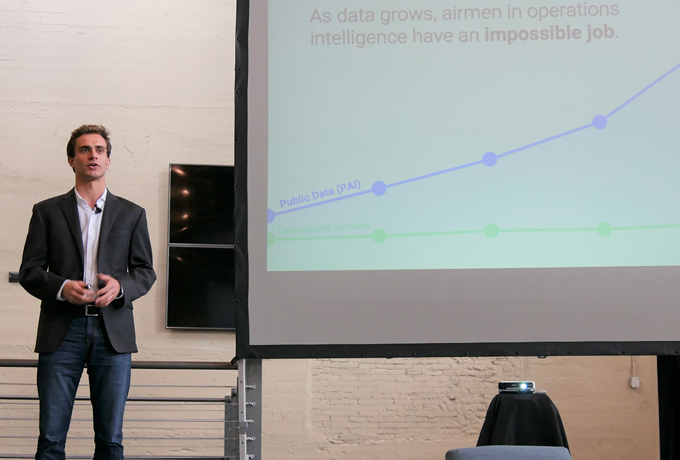DAYTON, Ohio – The team behind the Air Force’s Transition Accelerator hosted its first-ever Demo Day Pitch event April 5, featuring a group of eight technology companies pitching their innovative solutions to real Air Force problems to a live audience.
The event, held at the Steam Plant, an authentic downtown Dayton event space, was the highlight of 10 weeks of effort with eight Small Business Innovation Research (SBIR) companies from the Air Force Research Laboratory.
The Transition Accelerator is a partnership between AFRL’s Airman Systems Directorate, the Wright Brothers Institute, and The Entrepreneur Center. It leverages commercial accelerator methodologies, programs, and resources to support the Air Force’s SBIR goals. The Dayton-based program focuses on rapid commercialization of key technologies considered critical to the success of the Air Force. The pitches and demos showcased a new era of AFRL partnerships, encouraging quick and agile business processes and speeding up partnering timelines.
The Transition Accelerator has a goal to shorten timelines to get new technology into the hands of warfighters faster by reducing transition timelines overall.
The SBIR program is a highly competitive program that encourages domestic small businesses and startups to engage in Federal research and development that has the potential for commercialization. Through a competitive awards-based program, SBIR enables small businesses to explore their technological potential and provides the incentive to profit from its commercialization.
This pitch event called upon highly qualified small businesses to help inject entrepreneurial flavor into the research and development arena. By introducing this Accelerator model into a SBIR program, AFRL opens up new conduits for small businesses and start-ups to work with the Department of Defense in valuable and meaningful ways.
“This new frontier within the DOD is a harbinger of continued movement toward innovation and cutting-edge advances in technology,” according to the T3 website.
The event featured two 30-minute pitch sessions, with each session featuring four companies. In the first 30 minutes, audience members heard from Alex Sands from Plasticity, and how natural language processing can assist Intelligence, Surveillance, and Reconnaissance Analysts across the Air Force. Next was Chad Weiss, from Aptima Inc., followed by Brian Cooney from 361 Interactive. 361 Interactive pitched an imagery analysis capability that speeds up the process of data collection and image analysis using human-machine teaming. The final pitch of the first session came from Scott Grigsby from SoarTech, a company innovating project management software.
Between pitch sessions, David Shahady, director of the Air Force Small Business Innovation Research and Small Business Technology Transfer Program, spoke with Candace Dalmagne-Rouge from Startup Grind, a global startup community designed to educate, inspire and connect entrepreneurs.
“Innovation is all about delivering things,” Shahady said, discussing how programs like this Transition Accelerator are helping to bridge the gaps between AFRL and partners. “Those of us who are creative and forward-leaning have realized we are not alone. Over the past 10 years we’ve gone from being islands to connecting with bridges and roads.”
The remaining four small businesses presented their pitches, starting with Chris Wimmer from SA Wyze, a company addressing burnout through wearable tech and software/AI to monitor and assist with fatigue and proper follow-up. Alan Smith from Cognovi Labs spoke, followed by Tim Klein from Arete Associates. Wrapping up the event was Josh Gratsch from Ascend Innovations, another company focused on identifying fatigue through early warning signs and facial movement recognition.
“The Air Force invests in both innovation and innovators,” Shahady said. “The accelerator offers a novel approach to the business of teaming, allowing [AFRL] to instruct and mentor promising companies with promising technologies. [The Accelerator’s] ultimate goal is driving innovative capabilities to warfighters while fostering the growth of small businesses.”
As the event wound down with a networking event, it was clear that partnership was in the air. Folks mingled and connected, as representatives from each small business fielded questions on their projects.
“We want to be the venture capital backer to these entities,” Shahady remarked, and it was clear that the support and backing had nurtured these small businesses to be fully prepared for this event and, ultimately, strong, valuable partnerships.
For more information on T3, visit www.T3Accelerator.com.

